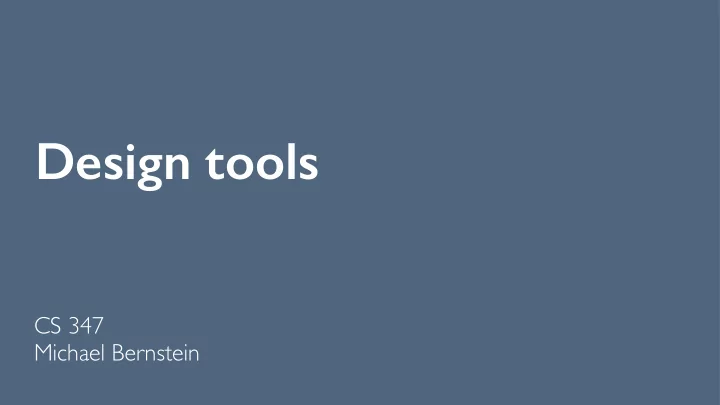

Design tools CS 347 Michael Bernstein
Announcements Projects: ready, set, go! 2
Feedback from CTL What you ask of yourselves in order to make the class more successful: participate in discussion What’s going well Lectures In-class polls and seeing disagreements Interactive discussion and direct engagement with TA gives actionable feedback 3
Feedback from CTL Suggested improvements Space office hours out more (yes, let’s do this) 1:1 project advising time outside of office hours (maybe an individual advising meeting with staff while picking projects?) Deadlines at 5pm and Friday evening don’t allow for work over the weekends or work-study students (Monday project deadlines instead?) Discussant prep needs more time than just starting at 5pm the night before (please take our survey in your email so we can improve this) 4
Y O U Recall one more R E A D T H I S time Implication: To improve the process, encourage more rapid reflection, or improve the quality of the reflection To improve the tools, create alternatives that make reflection easier to do or more informative 5
Goal: facilitate rapid iteration [Hartmann, PhD thesis ’09] Prototypes enable exploration and iteration around concrete artifacts The more fluid the prototyping process is, the more you can learn before you sink time into engineering 6
Design tools should... [Hartmann, PhD thesis ’09] Decrease UI construction time Isolate designers from implementation details Enable designers to explore an interface technology previously reserved to engineers or other technology experts 7
Today Rapid prototyping Exploring alternatives: design galleries Feedback Tangible and physical interaction 8
Rapid prototyping
Y O U Recall: Sketching Interfaces Like Krazy R E A D T H [Landay, CHI ’96] I S Combine the fluidity of paper-based sketching with the interactivity of tools Technique: sketch recognition of basic UI components Led to many projects on lower fidelity prototyping of interactive systems: let’s tour some of them 10
DENIM: web storyboarding [Lin et al., CHI ’00] Enable fluid, informal interactions for web site design Work at a higher level of abstraction than HTML 11
Designer’s Outpost [Klemmer et al., UIST ’01] Fluid interactive brainstorming that bridges physical and digital artifacts 12
$1 gesture recognizer [Wobbrock, Wilson, and Li, UIST ’07] Training an end-to-end ML system for gesture recognition would take thousands of examples and a lot of time—infeasible for prototyping The “$1 recognizer”: quick 100 lines of code for 97% accuracy with only one example Resample, rescale, rotate, and template match 13
Exploring alternatives
Design galleries [Marks et al., SIGGRAPH ’97] Automatically generate perceptually-varying alternatives within a design space Helps the designer explore other feasible approaches Now a widely-adopted technique inside of design tools 15
Recall: Juxtapose 16
Recall: DesignScape [O’Donovan, Agarwala, and Hertzmann CHI ’15] Model graphic design requirements such as alignment and hierarchical segmentation, then generate alternatives 17
Feedback
Y O U R E A D T H I S Learning Visual Importance [Bylinskii et al., UIST ’17] 19
Voyant: crowd feedback [Xu, Huang, and Bailey CSCW ’13] 20
Physical and tangible interface prototyping
The challenge of physical prototyping Prototype the bits, or prototype the atoms? Goal: lower the threshold to prototype interactive systems that depend on electronics and physical materials 22
Y O U R E A D T H I S Recall: Juxtapose 23
Phidgets The first physical prototyping platform USB plug-and- programmable I/O servos, LEDs, buttons, sliders, etc. Goal: program physical devices like you would a GUI widget 24
Led to: Arduino Maker board for artists, programmers and hobbyists 25
Led to: Makey Makey [Silver et al., TEI ’12] Alligator clips map onto keystrokes 26
d.tools: prototyping behavior [Hartmann et al., UIST ’06] Plug-and-play HW, visual statechart behaviors 27
Sensor interaction by demonstration [Hartmann et al., CHI ’07] 28
Fabricating capacitive hardware [Savage et al., UIST ’12] Author behaviors, and the software does circuit layout 29
Replacing electronics with cameras [Savage et al., UIST ’13] Create the physical prototype in CAD software, then use 3D printing and a camera to try out the interaction without building the electronics
CircuitStack [Wang et al. 2016] Prototype systems more quickly by removing wiring errors Author the wiring in software (Fritzing), then print out circuit paper that you can layer into the actual circuit and just place the components 31
Scanalog [Strasnick, Agrawala and Follmer 2017] 32
More to come… Programming (methods for engineering as opposed to prototyping) AI+HCI (AI as an amplifier for designers) ICT4D (design methods for developing regions) Cognition (engineering psychology of design) Visualization (design of information graphics) Critiques of HCI (issues derived from our design process) 33
Discussion Find today’s discussion room at http://hci.st/room
Recommend
More recommend